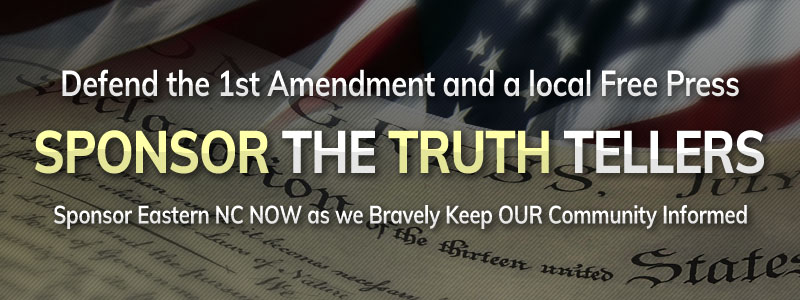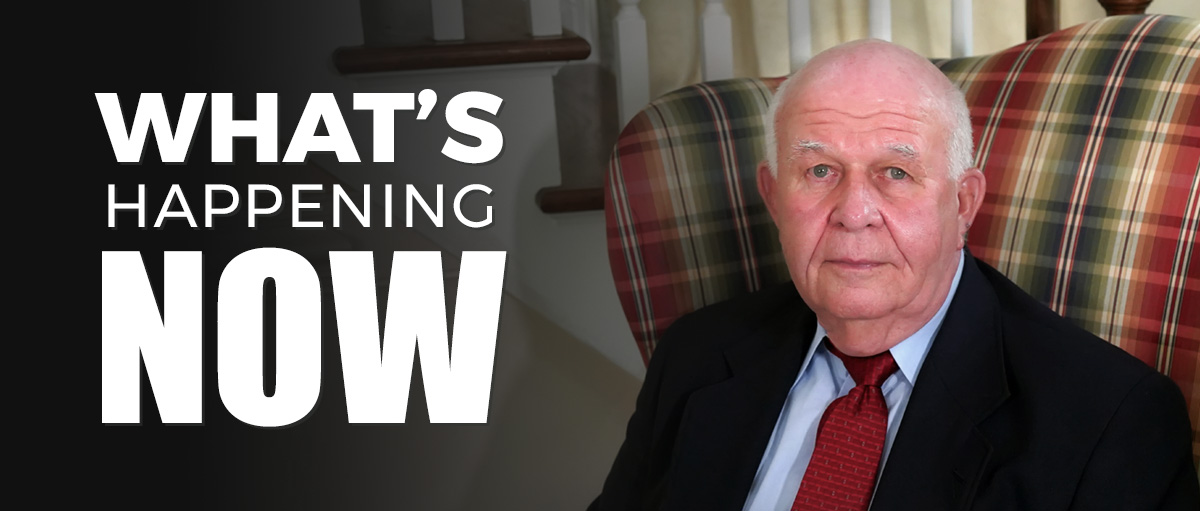Boldly Committed to Truth Telling in the False Face of Fakery
RELIGIOUS LIBERTY: Why Such Hostility to This Fundamental Freedom?
"I believe in Christianity as I believe that the sun has risen - not only because I see it, but because by it, I see everything else." - C.S. Lewis
It is absolutely clear that religion in this country has come under an attack from the ideological progressive left. Religion, religious leaders, religious business owners, and religious organizations have been demonized, vilified, slandered, and bullied all because they dare to stand firm in their religious beliefs. Segments of established churches, such as the Methodist Church and the Catholic Church, are demanding that they ignore and even revise the religious principles they stand for and promote. They want to get rid of the "marriage is between one man and one woman" and "man shall not lie with another man" religious teachings so that the churches can fall in line with today's social progression.
The First amendment contains two separate protections when it comes to religion and religious exercise. It reads: "Congress shall make no law respecting an establishment of religion, or prohibiting the free exercise thereof; or abridging the freedom of speech, or of the press; or the right of the people peaceably to assemble, and to petition the Government for a redress of grievances." Religious Liberty is the first of our fundamental rights to be addressed in the Bill of Rights. The first clause in the First Amendment ("Congress shall make no law respecting the establishment of religion") is known as the "Establishment Clause." This clause makes perfectly clear that the federal government (Congress) is prohibited the government from "establishing" a state-sponsored church, which is what Great Britain did in establishing the (Anglican) Church of England.
The second clause ["Congress shall make no law prohibiting the free exercise (of one's religion) thereof"] is known as the "Free Exercise Clause." The Free Exercise Clause reserves the right of American citizens to accept any religious belief and engage in religious rituals; that is, Americans are protected from government in their free exercise of their religious beliefs. The Free Exercise Clause not only protects religious belief and expression; it also seems to allow for violation of laws, as long as that violation is made for religious reasons.
Before we even had the Constitution and the First Amendment, religious liberty protections were already a priority in the minds of men such as Thomas Jefferson and James Madison. For example, the Virginia Statute for Religious Freedom, which was drafted by Jefferson in 1776 and accepted by the Virginia General Assembly in 1786, was one of the most important documents in early U.S. religious history. By its enactment, it ensured that all religious groups were placed on an equal footing so far as the State was concerned. The Virginia Statute marked the end of a ten-year struggle for the separation of church and state in Virginia, and it was, in fact, the driving force behind the religious clauses of the First Amendment of the U.S. Constitution, ratified in 1791. As Jefferson explained: The Virginia Statute for Religious Liberty was a first attempt to attempt to provide religious freedom to "the Jew, the Gentile, the Christian, the Mahometan, the Hindoo, and the infidel of every denomination." To explain it in terms of historical significance, it was the first attempt in the new nation to remove the government's influence from religious affairs.
Today, we (incorrectly) associate the phrase "Separation of Church and State" as explaining the meaning of the Establishment Clause. The question is: Where did this phrase come from? And what exactly does it mean? The phrase certainly appears in no official founding document. Leading religious experts have challenged politicians and jurists to find it
So, if the phrase "Separation of Church and State" appears in no official founding document, what is the source of that phrase? And how did it become so closely associated with the First Amendment? As we now know, the phrase came from a letter written by Thomas Jefferson.
On October 7, 1801, the Danbury Baptist Association of Danbury, Connecticut, sent a letter to President Thomas Jefferson expressing their concern that protection for religion had been written into the laws and constitutions. Believing strongly that freedom of religion was an inalienable right given by God, the fact that it appeared in civil documents suggested that the government viewed it as a government-granted rather than a God-given right. Apprehensive that the government might someday wrongly believe that it did have the power to regulate public religious activities, the Danbury Baptists communicated their anxiety to President Jefferson.
On January 1, 1802, Jefferson responded to their letter. He understood their concerns and agreed with them that man accounted only to God and not to government for his faith and religious practice. Jefferson emphasized to the Danbury Baptists that none of man's natural (ie, inalienable) rights, including the right to exercise one's faith publicly, would ever place him in a situation where the government would interfere with his religious expressions. He assured them that because of the 'wall of separation,' they need not fear government interference with religious expressions:
"Believing with you that religion is a matter which lies solely between man and his God,... I contemplate with sovereign reverence that act of the whole American people which declared that their legislature should "make no law respecting an establishment of religion or prohibiting the free exercise thereof," thus building a wall of separation between Church and State."
In his letter, Jefferson made clear that the "wall of separation" was erected not to limit public religious expressions but rather to provide security against governmental interference with those expressions, whether private or public. (On numerous other occasions, Jefferson repeatedly affirmed that the sole purpose of the First Amendment was to ensure that the federal government could not interfere with public religious expressions).
Later courts occasionally cited Jefferson's "separation" letter in their rulings. For example, in the 1878 case Reynolds v. United States, the Supreme Court quoted heavily from Jefferson's letter, noting with approval Jefferson's view that the federal government was not to interfere with religious expressions of values, except in a very narrow set of circumstances.
The case addressed the issue of religion and polygamy. George Reynolds, a member of the Church of Jesus Christ of Latter-day Saints, was charged with bigamy under the federal Morrill Anti-Bigamy Act after marrying a woman while still married to his previous wife. Reynolds argued that the law was unconstitutional. He reasoned that his religion required him to marry multiple women and the law therefore violated his First Amendment right to free exercise of religion. And so, he took this issue to court.
The specific question posed to the US Supreme Court is whether religious exercise or religious duty is a legitimate defense to a criminal charge. The Court, however, upheld Reynolds's conviction and Congress' power to prohibit polygamy. The Court held that while Congress could not outlaw a belief in the correctness of polygamy, it could outlaw the practice thereof. The majority reasoned that while marriage is a "sacred obligation," it is nevertheless "usually regulated by law" in "most civilized nations." The Court addressed Jefferson's letter to the Danbury Baptists and summarized it as follows:
"The rightful purposes of civil government are for its officers to interfere with religion only when its principles break out into overt acts against peace and good order. In this is found the true distinction between what properly belongs to the Church and what belongs to the State..... Congress was deprived of all legislative power over mere religious opinion but was left free to reach religious actions which were in violation of social duties or subversive of good order."
Ultimately, the Court held that people cannot ignore a law and avoid prosecution due to their religious beliefs.
Since the federal government was only to inhibit religious expressions that were "subversive of good order" or "broke out into overt acts against peace and good order," that Court (and other courts, including in Commonwealth v. Nesbit and Lindenmuller v. The People) provided examples of the types of "religious" acts into which the government did have legitimate reason to intrude - acts such as human sacrifice, concubinage, incest, polygamy, injury to children, etc. But in traditional religious practices (whether public prayer, the use of the Scriptures, etc), the government was never to interfere. This was the clearly-understood meaning of Jefferson's "separate" letter and the manner in which it was applied for a century and a half.
However, a reversal occurred in 1947, in the case of Everson v. Board of Education.
In 1947, the US Supreme Court began to reinterpret the First Amendment by re-interpreting the phrase "Wall of Separation Between Church and State," which is a legal fiction, in the case of Everson v. Board of Education of Ewing Township. At issue was a New Jersey law which authorized reimbursement by local school boards of the costs of transportation to and from schools, including private schools. 96% of the private schools who benefitted from this law were parochial Catholic schools. Arch R. Everson, a taxpayer in Ewing Township, filed a lawsuit alleging that this indirect aid to religion violated both the New Jersey state constitution and the First Amendment. After losing in state courts, Everson appealed to the U.S. Supreme Court on purely federal constitutional grounds.
Justice Hugo Black, a former KKK leader, wrote the majority opinion for the Supreme Court in Everson. The majority concluded that the New Jersey statute which permitted reimbursement to the parents of Catholic children for the cost of bus transportation as was available to children attending public school (and to those who chose, rather, to attend a parochial school) was valid in light of the Establishment Clause. Justice Black wrote: "The establishment of religion clause of the First Amendment means at least this: Neither a state nor the Federal Government can set up a church. Neither can pass laws which aid one religion, aid all religions, or prefer one religion over another." In his conclusion, Black added this phrase: "The First Amendment has erected a wall between church and state. That wall must be kept high and impregnable. We could not approve the slightest breach. New Jersey has not breached it here."
And since that 1947 opinion, the phrase "separation of church and state" no longer meant that the federal government (ie, the "state") could not establish a federal denomination (ie, a "church"), but has been re-interpreted to mean that public religious expressions (ie, the new "church") must be kept separate from the public square (ie, the new "state"). This change in definition has resulted in one absurd ruling after another, each one destroying our national identity bit by bit.
This is why I say that the "Wall of Separation" phrase is a legal fiction.
In 1962, the US Supreme Court began to remove religion from America's public schools, with the case Engel v. Vitale. In that case, the New York State Board of Regents authorized a short, voluntary prayer for recitation at the start of each school day. A group of organizations joined forces in challenging the prayer, claiming that it violated the Establishment Clause of the First Amendment. The New York Court of Appeals rejected their arguments. The question presented by this case was an extremely narrow one - whether New York overstepped constitutional bounds when it agreed to finance a religious exercise. Does the reading of a nondenominational prayer at the start of the school day violate the Establishment Clause of the First Amendment?
The Supreme Court held that the state cannot hold prayers in public schools, even if participation is not required and the prayer is not tied to a particular religion.
In an opinion authored by Hugo L. Black, the Court held that respondent's decision to use its school system to facilitate recitation of the official prayer violated the Establishment Clause. Specifically, the policy breached the constitutional "wall of separation between church and state," which he so 'eloquently' (sarcastic) and deceitfully articulated in his Everson opinion. The Court ruled that the constitutional prohibition of laws establishing religion meant that government had no business drafting formal prayers for any segment of its population to repeat in a government-sponsored religious program. The Court held that respondent's provision of the contested daily prayer was inconsistent with the Establishment Clause.
Justice William Douglas concurred in the judgment on the ground that the state's financing a religious exercise violated the First Amendment. In his concurring opinion, Douglas, explained: "We think that by using its public school system to encourage recitation of the Regents' prayer, the State of New York has adopted a practice wholly inconsistent with the Establishment Clause. There can, of course, be no doubt that New York's program of daily classroom invocation of God's blessings as prescribed in the Regents' prayer is a religious activity. It is a solemn avowal of divine faith and supplication for the blessings of the Almighty. The nature of such a prayer has always been religious....," and as such violates the "wall of separation" rule.
He continued:
"In New York, the teacher who leads in prayer is on the public payroll, and the time she takes seems minuscule . . . Yet, for me, the principle is the same, no matter how briefly the prayer is said, for, in each of the instances given, the person praying is a public official on the public payroll, performing a religious exercise in a governmental institution. It is said that the element of coercion is inherent in the giving of this prayer. If that is true here, it is also true of the prayer with which this Court is convened, and of those that open the Congress. Few adults, let alone children, would leave our courtroom or the Senate or the House while those prayers are being given. Every such audience is in a sense a 'captive' audience..... At the same time, I cannot say that to authorize this prayer is to establish a religion in the strictly historic meaning of those words. A religion is not established in the usual sense merely by letting those who choose to do so say the prayer that the public-school teacher leads. Yet once government finances a religious exercise, it inserts a divisive influence into our communities.....
The First Amendment leaves the Government in a position not of hostility to religion but of neutrality . . . The philosophy is that if government interferes in matters spiritual, it will be a divisive force. The First Amendment teaches that a government neutral in the field of religion."
Next came the removal of Bible reading at the start of each school day. In the case of Abington School District v. Schempp, a Pennsylvania law requiring public school teachers to read from the Bible at the beginning of each school day was challenged as being violative of the Establishment Clause of the First Amendment (and the Fourteenth Amendment, which incorporated the First Amendment on the States in the case Gitlow v. New York, in 1925). The issue presented to the Court was whether the Pennsylvania law requiring public school students to participate in classroom religious exercises violate the religious freedom of students as protected by the First and Fourteenth Amendments. The Court consolidated this case with one involving Maryland atheists (headed by the infamous atheist and hedonist, Madalyn Murray O'Hair), who challenged a Baltimore city rule that provided for opening exercises in the public schools that consisted primarily of reading a chapter from the bible and the Lord's Prayer. (Murray v. Curlett). When Maryland's highest court held that in-school Bible readings did not violate the First Amendment, O'Hair appealed to the US Supreme Court. The case was then consolidated with the Abington v. Schempp case.
The Supreme Court concluded that public schools cannot sponsor Bible readings and/or recitations of the Lord's Prayer under the First Amendment's Establishment Clause. In an opinion written by Justice Clark, the majority concluded that, in both cases, the laws required religious exercises and such exercises directly violated the First Amendment.
Go Back
It is absolutely clear that religion in this country has come under an attack from the ideological progressive left. Religion, religious leaders, religious business owners, and religious organizations have been demonized, vilified, slandered, and bullied all because they dare to stand firm in their religious beliefs. Segments of established churches, such as the Methodist Church and the Catholic Church, are demanding that they ignore and even revise the religious principles they stand for and promote. They want to get rid of the "marriage is between one man and one woman" and "man shall not lie with another man" religious teachings so that the churches can fall in line with today's social progression.
The First amendment contains two separate protections when it comes to religion and religious exercise. It reads: "Congress shall make no law respecting an establishment of religion, or prohibiting the free exercise thereof; or abridging the freedom of speech, or of the press; or the right of the people peaceably to assemble, and to petition the Government for a redress of grievances." Religious Liberty is the first of our fundamental rights to be addressed in the Bill of Rights. The first clause in the First Amendment ("Congress shall make no law respecting the establishment of religion") is known as the "Establishment Clause." This clause makes perfectly clear that the federal government (Congress) is prohibited the government from "establishing" a state-sponsored church, which is what Great Britain did in establishing the (Anglican) Church of England.
The second clause ["Congress shall make no law prohibiting the free exercise (of one's religion) thereof"] is known as the "Free Exercise Clause." The Free Exercise Clause reserves the right of American citizens to accept any religious belief and engage in religious rituals; that is, Americans are protected from government in their free exercise of their religious beliefs. The Free Exercise Clause not only protects religious belief and expression; it also seems to allow for violation of laws, as long as that violation is made for religious reasons.
Before we even had the Constitution and the First Amendment, religious liberty protections were already a priority in the minds of men such as Thomas Jefferson and James Madison. For example, the Virginia Statute for Religious Freedom, which was drafted by Jefferson in 1776 and accepted by the Virginia General Assembly in 1786, was one of the most important documents in early U.S. religious history. By its enactment, it ensured that all religious groups were placed on an equal footing so far as the State was concerned. The Virginia Statute marked the end of a ten-year struggle for the separation of church and state in Virginia, and it was, in fact, the driving force behind the religious clauses of the First Amendment of the U.S. Constitution, ratified in 1791. As Jefferson explained: The Virginia Statute for Religious Liberty was a first attempt to attempt to provide religious freedom to "the Jew, the Gentile, the Christian, the Mahometan, the Hindoo, and the infidel of every denomination." To explain it in terms of historical significance, it was the first attempt in the new nation to remove the government's influence from religious affairs.
Today, we (incorrectly) associate the phrase "Separation of Church and State" as explaining the meaning of the Establishment Clause. The question is: Where did this phrase come from? And what exactly does it mean? The phrase certainly appears in no official founding document. Leading religious experts have challenged politicians and jurists to find it
So, if the phrase "Separation of Church and State" appears in no official founding document, what is the source of that phrase? And how did it become so closely associated with the First Amendment? As we now know, the phrase came from a letter written by Thomas Jefferson.
On October 7, 1801, the Danbury Baptist Association of Danbury, Connecticut, sent a letter to President Thomas Jefferson expressing their concern that protection for religion had been written into the laws and constitutions. Believing strongly that freedom of religion was an inalienable right given by God, the fact that it appeared in civil documents suggested that the government viewed it as a government-granted rather than a God-given right. Apprehensive that the government might someday wrongly believe that it did have the power to regulate public religious activities, the Danbury Baptists communicated their anxiety to President Jefferson.
On January 1, 1802, Jefferson responded to their letter. He understood their concerns and agreed with them that man accounted only to God and not to government for his faith and religious practice. Jefferson emphasized to the Danbury Baptists that none of man's natural (ie, inalienable) rights, including the right to exercise one's faith publicly, would ever place him in a situation where the government would interfere with his religious expressions. He assured them that because of the 'wall of separation,' they need not fear government interference with religious expressions:
"Believing with you that religion is a matter which lies solely between man and his God,... I contemplate with sovereign reverence that act of the whole American people which declared that their legislature should "make no law respecting an establishment of religion or prohibiting the free exercise thereof," thus building a wall of separation between Church and State."
In his letter, Jefferson made clear that the "wall of separation" was erected not to limit public religious expressions but rather to provide security against governmental interference with those expressions, whether private or public. (On numerous other occasions, Jefferson repeatedly affirmed that the sole purpose of the First Amendment was to ensure that the federal government could not interfere with public religious expressions).
Later courts occasionally cited Jefferson's "separation" letter in their rulings. For example, in the 1878 case Reynolds v. United States, the Supreme Court quoted heavily from Jefferson's letter, noting with approval Jefferson's view that the federal government was not to interfere with religious expressions of values, except in a very narrow set of circumstances.
The case addressed the issue of religion and polygamy. George Reynolds, a member of the Church of Jesus Christ of Latter-day Saints, was charged with bigamy under the federal Morrill Anti-Bigamy Act after marrying a woman while still married to his previous wife. Reynolds argued that the law was unconstitutional. He reasoned that his religion required him to marry multiple women and the law therefore violated his First Amendment right to free exercise of religion. And so, he took this issue to court.
The specific question posed to the US Supreme Court is whether religious exercise or religious duty is a legitimate defense to a criminal charge. The Court, however, upheld Reynolds's conviction and Congress' power to prohibit polygamy. The Court held that while Congress could not outlaw a belief in the correctness of polygamy, it could outlaw the practice thereof. The majority reasoned that while marriage is a "sacred obligation," it is nevertheless "usually regulated by law" in "most civilized nations." The Court addressed Jefferson's letter to the Danbury Baptists and summarized it as follows:
"The rightful purposes of civil government are for its officers to interfere with religion only when its principles break out into overt acts against peace and good order. In this is found the true distinction between what properly belongs to the Church and what belongs to the State..... Congress was deprived of all legislative power over mere religious opinion but was left free to reach religious actions which were in violation of social duties or subversive of good order."
Ultimately, the Court held that people cannot ignore a law and avoid prosecution due to their religious beliefs.
Since the federal government was only to inhibit religious expressions that were "subversive of good order" or "broke out into overt acts against peace and good order," that Court (and other courts, including in Commonwealth v. Nesbit and Lindenmuller v. The People) provided examples of the types of "religious" acts into which the government did have legitimate reason to intrude - acts such as human sacrifice, concubinage, incest, polygamy, injury to children, etc. But in traditional religious practices (whether public prayer, the use of the Scriptures, etc), the government was never to interfere. This was the clearly-understood meaning of Jefferson's "separate" letter and the manner in which it was applied for a century and a half.
However, a reversal occurred in 1947, in the case of Everson v. Board of Education.
In 1947, the US Supreme Court began to reinterpret the First Amendment by re-interpreting the phrase "Wall of Separation Between Church and State," which is a legal fiction, in the case of Everson v. Board of Education of Ewing Township. At issue was a New Jersey law which authorized reimbursement by local school boards of the costs of transportation to and from schools, including private schools. 96% of the private schools who benefitted from this law were parochial Catholic schools. Arch R. Everson, a taxpayer in Ewing Township, filed a lawsuit alleging that this indirect aid to religion violated both the New Jersey state constitution and the First Amendment. After losing in state courts, Everson appealed to the U.S. Supreme Court on purely federal constitutional grounds.
Justice Hugo Black, a former KKK leader, wrote the majority opinion for the Supreme Court in Everson. The majority concluded that the New Jersey statute which permitted reimbursement to the parents of Catholic children for the cost of bus transportation as was available to children attending public school (and to those who chose, rather, to attend a parochial school) was valid in light of the Establishment Clause. Justice Black wrote: "The establishment of religion clause of the First Amendment means at least this: Neither a state nor the Federal Government can set up a church. Neither can pass laws which aid one religion, aid all religions, or prefer one religion over another." In his conclusion, Black added this phrase: "The First Amendment has erected a wall between church and state. That wall must be kept high and impregnable. We could not approve the slightest breach. New Jersey has not breached it here."
And since that 1947 opinion, the phrase "separation of church and state" no longer meant that the federal government (ie, the "state") could not establish a federal denomination (ie, a "church"), but has been re-interpreted to mean that public religious expressions (ie, the new "church") must be kept separate from the public square (ie, the new "state"). This change in definition has resulted in one absurd ruling after another, each one destroying our national identity bit by bit.
This is why I say that the "Wall of Separation" phrase is a legal fiction.
In 1962, the US Supreme Court began to remove religion from America's public schools, with the case Engel v. Vitale. In that case, the New York State Board of Regents authorized a short, voluntary prayer for recitation at the start of each school day. A group of organizations joined forces in challenging the prayer, claiming that it violated the Establishment Clause of the First Amendment. The New York Court of Appeals rejected their arguments. The question presented by this case was an extremely narrow one - whether New York overstepped constitutional bounds when it agreed to finance a religious exercise. Does the reading of a nondenominational prayer at the start of the school day violate the Establishment Clause of the First Amendment?
The Supreme Court held that the state cannot hold prayers in public schools, even if participation is not required and the prayer is not tied to a particular religion.
In an opinion authored by Hugo L. Black, the Court held that respondent's decision to use its school system to facilitate recitation of the official prayer violated the Establishment Clause. Specifically, the policy breached the constitutional "wall of separation between church and state," which he so 'eloquently' (sarcastic) and deceitfully articulated in his Everson opinion. The Court ruled that the constitutional prohibition of laws establishing religion meant that government had no business drafting formal prayers for any segment of its population to repeat in a government-sponsored religious program. The Court held that respondent's provision of the contested daily prayer was inconsistent with the Establishment Clause.
Justice William Douglas concurred in the judgment on the ground that the state's financing a religious exercise violated the First Amendment. In his concurring opinion, Douglas, explained: "We think that by using its public school system to encourage recitation of the Regents' prayer, the State of New York has adopted a practice wholly inconsistent with the Establishment Clause. There can, of course, be no doubt that New York's program of daily classroom invocation of God's blessings as prescribed in the Regents' prayer is a religious activity. It is a solemn avowal of divine faith and supplication for the blessings of the Almighty. The nature of such a prayer has always been religious....," and as such violates the "wall of separation" rule.
He continued:
"In New York, the teacher who leads in prayer is on the public payroll, and the time she takes seems minuscule . . . Yet, for me, the principle is the same, no matter how briefly the prayer is said, for, in each of the instances given, the person praying is a public official on the public payroll, performing a religious exercise in a governmental institution. It is said that the element of coercion is inherent in the giving of this prayer. If that is true here, it is also true of the prayer with which this Court is convened, and of those that open the Congress. Few adults, let alone children, would leave our courtroom or the Senate or the House while those prayers are being given. Every such audience is in a sense a 'captive' audience..... At the same time, I cannot say that to authorize this prayer is to establish a religion in the strictly historic meaning of those words. A religion is not established in the usual sense merely by letting those who choose to do so say the prayer that the public-school teacher leads. Yet once government finances a religious exercise, it inserts a divisive influence into our communities.....
The First Amendment leaves the Government in a position not of hostility to religion but of neutrality . . . The philosophy is that if government interferes in matters spiritual, it will be a divisive force. The First Amendment teaches that a government neutral in the field of religion."
Next came the removal of Bible reading at the start of each school day. In the case of Abington School District v. Schempp, a Pennsylvania law requiring public school teachers to read from the Bible at the beginning of each school day was challenged as being violative of the Establishment Clause of the First Amendment (and the Fourteenth Amendment, which incorporated the First Amendment on the States in the case Gitlow v. New York, in 1925). The issue presented to the Court was whether the Pennsylvania law requiring public school students to participate in classroom religious exercises violate the religious freedom of students as protected by the First and Fourteenth Amendments. The Court consolidated this case with one involving Maryland atheists (headed by the infamous atheist and hedonist, Madalyn Murray O'Hair), who challenged a Baltimore city rule that provided for opening exercises in the public schools that consisted primarily of reading a chapter from the bible and the Lord's Prayer. (Murray v. Curlett). When Maryland's highest court held that in-school Bible readings did not violate the First Amendment, O'Hair appealed to the US Supreme Court. The case was then consolidated with the Abington v. Schempp case.
The Supreme Court concluded that public schools cannot sponsor Bible readings and/or recitations of the Lord's Prayer under the First Amendment's Establishment Clause. In an opinion written by Justice Clark, the majority concluded that, in both cases, the laws required religious exercises and such exercises directly violated the First Amendment.
























